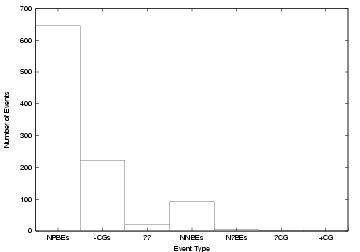


Energetic intracloud events have previously been referred to as compact intracloud discharges (CIDs), energetic bipolars, and bipolar events. Their emissions have also been referred to with multiple terms, generally based on the specific signature in the data set, rather than any physical process or mechanism. The field change waveforms have been described as narrow positive and narrow negative bipolar pulses (+/- NB). Energetic intracloud VHF emissions, when recorded from space along with a ground reflection, were dubbed transionospheric pulse pairs (TIPPs).
Terminology notwithstanding, energetic ICs are distinguished from other lightning events by several noteworthy characteristics, including the following: 1. The discharges are among the most powerful source of lightning radiation in the HF/VHF radio bands 2. Energetic ICs are typically isolated in time from other detectable discharges on a time scale of at least a few milliseconds, but often represent the initial event in an otherwise `normal' intracloud lightning flash 3. Energetic ICs occur in both positive and negative polarities.
